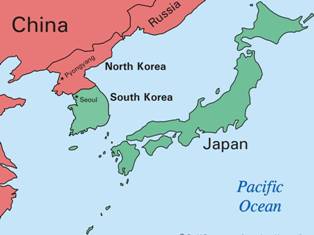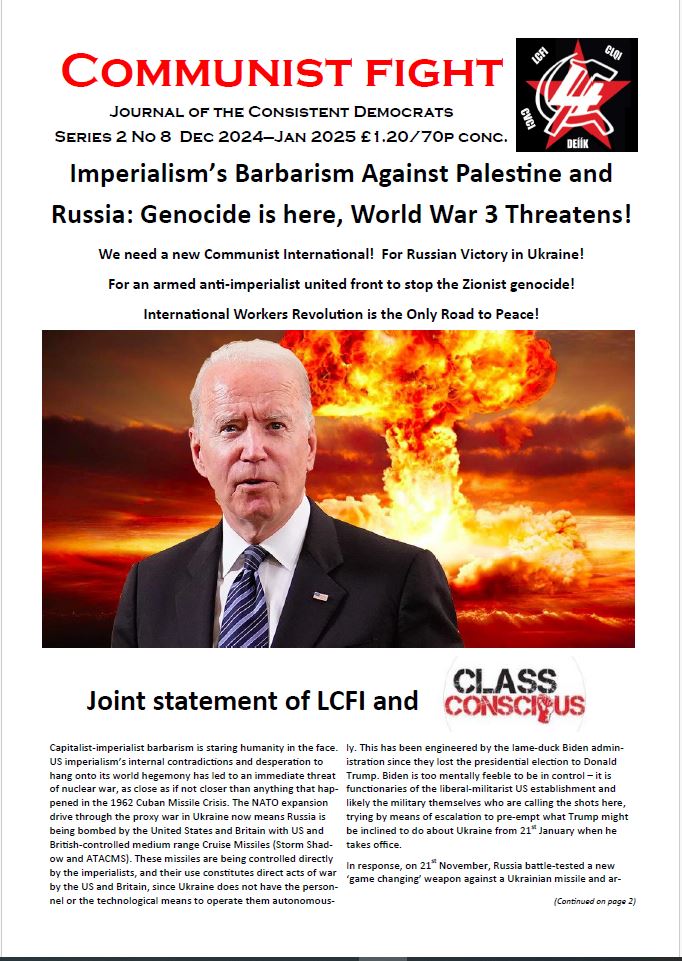
Japan, though a stagnant imperialist economic power, is a military colony of the United States. Since its humiliating and bloody defeat in World War II, with the unprecedented attack of two atomic bombs, the eastern archipelago has been occupied by 119 military bases and 54,000 American soldiers . Now, with the decline of the imperialist system established since 1945, the United States is making a qualitative leap in Japan’s vassalage situation, preparing it to play a role similar to that of Ukraine against Russia in the future war against China.
The Asia-Pacific area is the third international front open today. In the Asia-Pacific area itself, the Anglo-Saxon bloc led by US imperialism with the integration of Japan seeks to contain China. In Eastern Europe, starting from the conflict in Ukraine, with the support of the imperialist powers of Continental Europe, the Anglo-Saxon bloc with its pivot in the United States seeks to advance on Russia. In Western Asia, with the organic link of the Anglo-Saxon-Zionist bloc, it seeks to advance on Iran.

“As a clear example of working together, the United States is collaborating with Japan in the construction of its first post-war aircraft carriers. Last Saturday, the Japanese ship JS Kaga arrived off the coast of San Diego to conduct flight tests with F-35B fighters and pave ‘the way for greater interoperability,’ as stated.”
“Shigeru Ishiba, the veteran politician who became a central figure in Japanese politics for more than three decades, has finally achieved his goal of leading the Liberal Democratic Party (LDP) and thereby assuming the post of Japan’s prime minister. Ishiba’s arrival represents a reorientation in critical areas of foreign and defense policy, just as Japan faces growing geopolitical challenges, both regionally and globally.” (Translated from https://www.escenariomundial.com/2024/10/09/estados-unidos-esta-ayudando-a-japon-a-construir-sus-primeros-portaaviones-de-posguerra/)
“Ishiba’s policy is also aligned with efforts to enhance multilateral cooperation in the region. Initiatives such as the Quad (which includes Japan, the United States, Australia, and India) could be strengthened under his watch, as Japan would seek flexible, targeted alliances to address challenges such as maritime security, cybersecurity, and deterrence against China’s actions in the South China Sea. This pragmatic approach could offer Japan a more influential position in the region, without the need to form formal alliances such as NATO, which would face historical and political resistance.” ( Translated from https://www.escenariomundial.com/2024/10/09/el-nuevo-marco-de-seguridad-de-japon-bajo-shigeru-ishiba/ )
Still, militarists in Japan still face contradictions within Japanese imperialism itself over sectors economically linked by trade and investment with China:
“Japan’s main export partners in 2022 were China (19.4%), the United States (18.7%), South Korea (7.2%), Hong Kong (4.4%) and Thailand (4.3%); while imports came mainly from China (21%), the United States (10.1%), Australia (9.8%), the UAE (5.1%) and Saudi Arabia (4.7%) “ (Translated from https://santandertrade.com/es/portal/analizar-mercados/japon/cifras-comercio-exterior).
In the document China and Hong Kong are separated and yet it shows us the degree of linkage that a sector of the Japanese bourgeoisie has with China for trade and investment, this sector of the same Japanese bourgeoisie being the most conciliatory with China itself.
Even so, since the end of the Second World War, Japan has been linked in an organic form of subordination to the United States, thus giving rise to what could be called Ameripan, where after the Second World War Japanese imperialism was rebuilt from American imperialism. Based on Japan’s geostrategic situation with maritime borders with China and the Soviet Union.
In this sense, the reconstruction of Japanese imperialism as a US protectorate was comparable to the reconstruction of West German imperialism in the post-war period as a means of containment of Eastern Europe linked to the Soviet Union and although it never constituted an imperialist state, the same tendency is partially seen in South Korea with the 38th parallel that separates it from the workers’ state of North Korea, which in turn had borders with the Soviet Union and People’s China.
With the rise of the militarists of Japanese imperialism, the anti-China siege from Japan would be added to the AUKUS alliance of the Anglo-Saxon powers constituted by the United States, the United Kingdom and Australia in the Pacific and the QUAD through which the United States, Japan and Australia seek to add India to the anti-China containment strategy.

